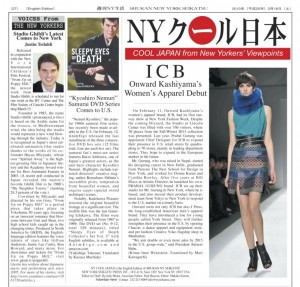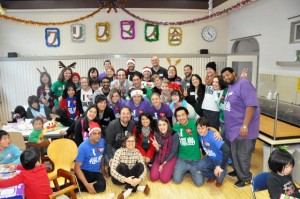Justin’s Japan: Nippon in New York — Japan Day @ Central Park and a ‘Deadly She-Wolf’

CNN national correspondent Sandra Endo hosts Japan Day @ Central Park May 12. (Courtesy of @sandraendotv)
By JQ magazine editor Justin Tedaldi (CIR Kobe-shi, 2001-02) for Examiner.com. Visit his Japanese culture page here for related stories.
This month’s highlights include:
Sunday, May 12, 10:30 a.m.
Free
Now in its seventh year, Japan Day has won acclaim from New Yorkers from every walk of life, with Mayor Michael Bloomberg calling it an eagerly anticipated cultural event on the city’s calendar. For this year’s event, organizers are planning once again to have both the Japan Run (beginning at 8:00 a.m.) and the Japan Day Festival, emphasizing enjoyable activities for all ages that will deepen participants’ understanding and appreciation of Japanese culture—not to mention the food, drinks and snacks! Hosted by CNN national correspondent Sandra Endo, this year’s guest performers include Taiko Masala, Kylee, Yosakoi Dance Project 10tecomai, Chris Hart, and the Glory Gospel Singers.
May 16-June 2
Deadly She-Wolf Assassin at Armageddon!
La MaMa Experimental Theatre, 74 East 4th Street
$30 adults, $25 students/seniors
Deadly She-Wolf Assassin at Armageddon! is the latest music/theater and martial arts tour de force from collaborators Fred Ho and Ruth Margraff. A daring and imaginative homage to the 1970s Japanese raging cult manga and theatrical hit Lone Wolf and Cub (Kozure Ookami)—which has inspired many other adaptations and works in comic books and film over the past decades—Deadly She-Wolf explodes with a ferocious stylistic mix of Japanese Noh theater and modern-day anime and manga influences with unique multi-martial arts and sword fighting choreography and a glorious score fusing traditional Japanese music and soul-jazz. Raised as a weapon by a brutal conspirator, a young female assassin discovers that her target has spun the empire of Japan into crisis and ruin–and–is none other than her father. Torn between loyalty to her mission, her nation and her soul, she must face the unimaginable at the twilight of an imperial epoch.
For the complete story, click here.
JQ Magazine: Cultural Heritage Soars in San Francisco’s Japantown

Under the Peace Pagoda at the Northern California Cherry Blossom Festival, San Francisco, April 2013. (Preston Hatfield)
By Preston Hatfield (Yamanashi-ken, 2009-10) for JQ magazine. Preston received a B.A. in English literature with an emphasis in creative writing and a minor in Japanese at the University of California, Davis. After spending an amazing year on JET in Yamanashi, he spent a year writing and interning with book publishing companies in New York. He currently lives in Marin County, where he continues to cover local Japan-related stories for JQ, and teaches English as a second language at an international school in San Francisco.
This April marks the forty-sixth time that San Francisco has hosted the Northern California Cherry Blossom Festival. As one of the world’s top annual festivals of its kind and one of the largest Japanese American events in the country, the festival has made quite a reputation for itself, and each year it’s bigger and better. Whether you’ve been to Japan before and need a fix of your favorite street food, or you’re a newbie interested in exploring the culture, the NCCBF offers a comprehensive and top-notch Japan experience that includes traditional and modern elements.
If you’ve been to other festivals, you already know to expect tea ceremony demonstrations, doll exhibits, taiko performances, and cosplay competitions, but pay attention and you’ll also notice a powerful sense of community in every act and exhibit. Excepting a handful of wonderful guests from Japan (including this year’s Grand Marshal, renowned singer and actor Teruhiko Saigo), the NCCBF is put on wholly by the Bay Area’s Japanese American community, including some 300 volunteers, 50 organizations, schools, and groups, and is sponsored by a number of local businesses. In some respects, it’s their way of making a statement, as Allen Okamoto, co-chairman of the NCCBF, explains:
“One of the reasons I continue to volunteer with the festival is that Japantown is rapidly changing. The demographics of the community are changing with the intermarriage and lack of migration from Japan. I consider the festival as an institution the same as the Japanese language schools, the churches and other community organizations like the Japanese Community Youth Council, Kimochi, Inc. and the Japanese Cultural & Community Center. We are all continuing the culture and heritage of things Japanese.”
The festival has become something of a culture treasure here, and it’s no wonder. San Francisco, with a formidable but recently declining Japanese American population, is home to one of the last “true” Japantowns in the U.S., but some locals think that’s debatable. “I saw [at the festival] a hardworking community [bringing] culture and fun to Japantown, which for the rest of the year is slowly being eaten by non-Japanese businesses. Koreatown sometimes feels more appropriate,” said Bay Area resident and JET alum Mikeal Gibson.
Kyodo News “Rural JET alumni” series: Darryl Wharton-Rigby (Fukushima)
News agency Kyodo News has recently been publishing monthly articles written by JET alumni who were appointed in rural areas of Japan, as part of promotion for the JET Programme. Below is the English version of the column from April 2013. Posted by Celine Castex (Chiba-ken, 2006-11), currently programme coordinator at CLAIR Tokyo.
***********
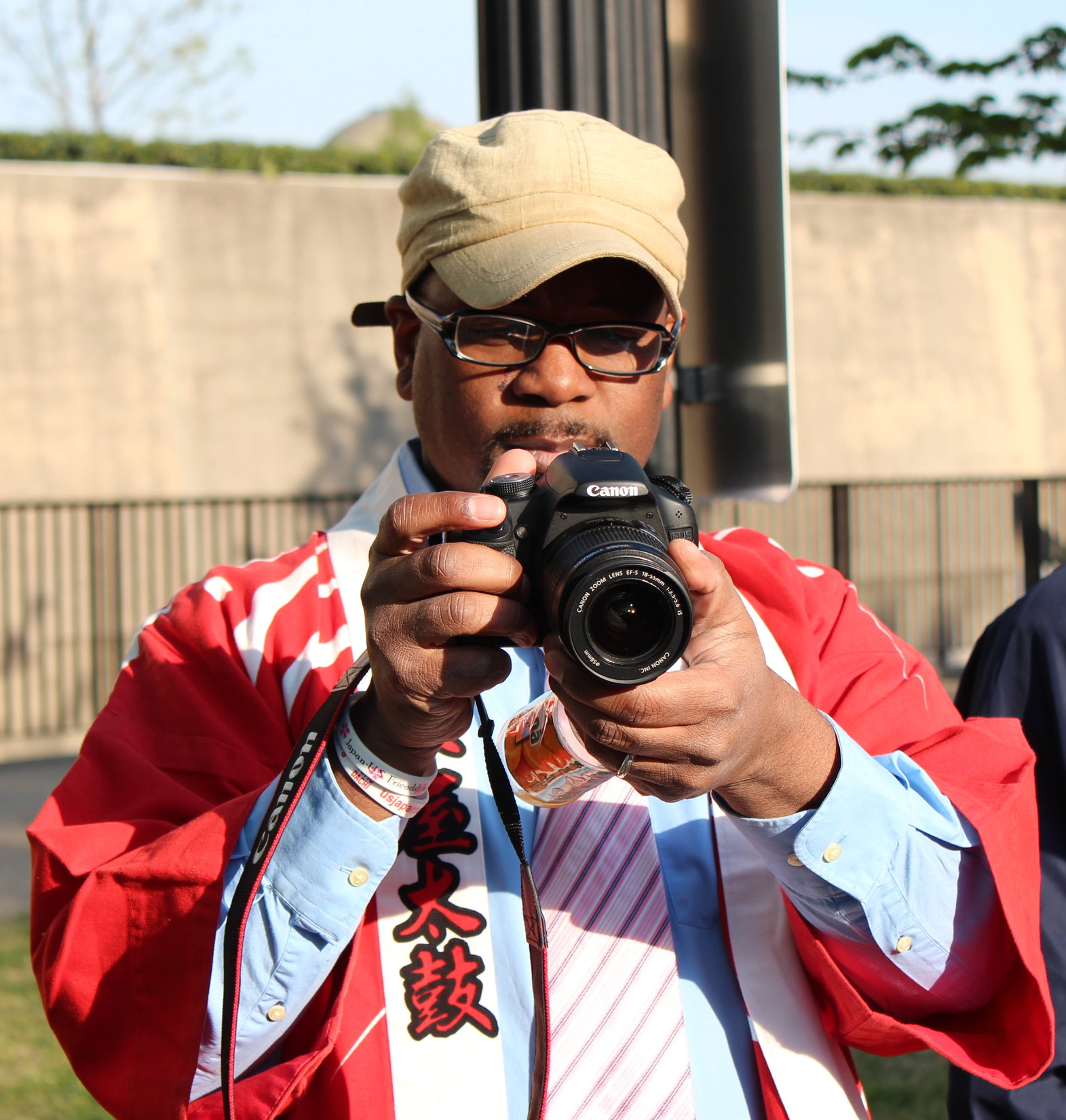
“I do not know how much of an impact I will have on the people I have met while I have been in Japan but I do know they have had a great impact on mine. Had I not applied for the JET Programme, I do not know what my life would be today.”
Writer, director, and professor, Darryl Wharton-Rigby (Fukushima-ken, Kawamata-machi, 2005-07) hails from a family of poets and storytellers in Baltimore, Maryland. He has earned a BA in History from Ithaca College and a MFA in Film Directing from Chapman University. After being hired by MTV Films to write a screenplay based on the Japanese manga TokyoTribe 2, he moved to Japan and taught English in a small town in Fukushima. He shot his latest short film, Obon, in the town of Natori, which is one of the areas of Japan hardest hit by the earthquake and tsunami. He is now working on a documentary, Don Doko Don: The Yamakiya Taiko Club Story, about a group of young drummers who were displaced due to high levels of radiation in their community from the failed nuclear plant. He has earned awards and grants from the Urbanworld Film Festival, the Maryland State Arts Council, The Painted Bride Arts Center, the Black Filmmakers Hall of Fame, and the Caucus Foundation for his work. He splits his time between Baltimore, Los Angeles and Japan where he currently lives, and credits his wife and three children as his ultimate muse.
A lifetime of happiness
One of the most satisfying and rewarding jobs in my life was working as an ALT in Kawamata in Fukushima Prefecture, Japan from 2005–2007. I have learned over the years that everything happens for a reason and that sometimes in life we are chosen to be at a certain place at a certain time.
I was 37 years old and living in Los Angeles, CA. I was living the life of a struggling filmmaker and needed a change, a break, from my career in film, television, and theatre. Since my first trip to Tokyo on a business trip for MTV I had been longing to return to Japan, because I knew there was more for me to learn and know about Japan. Applying for the JET Programme seemed the perfect opportunity.
From the moment I got accepted, life has moved at a rapid pace. I was placed in Kawamata, in Fukushima Prefecture, a quiet town with rice fields and rivers surrounded by mountains. My life in Kawamata was an adventure every day. I worked in two junior high schools, several elementary schools and kindergartens. It always brought a smile to my face, when I would hear students call my name, “Dariru-sensei!” I did my best to help the Japanese teachers in the classroom with activities and games. I got to know many of the students and could tell the ones who were enthusiastic towards learning English. Read More
Job: Reporter / Researcher – Yomiuri NY
Thanks to JET alum and journalist Olivia Nilsson for sharing this excellent JET-relevant opportunity. Posted by Kay Monroe (Miyazaki-shi, 1995 -97). Click here to join the JETwit Jobs Google Group and receive job listings even sooner by email.
————————————————————————————————————
Position: Reporter /Researcher
Posted by: The Yomiuri Shimbun
Type: Full-time
Location: NY
Salary: Approximate $40,000 with health insurance
Start Date: Immediately
Qualifications:
Applicants should have a background in international relations, foreign policy or journalism. Attention to accuracy and the faculty to multitask effectively under daily deadline pressure is required. Ability to develop and maintain good sources, a strong work ethic and ability to take direction well and work collaboratively with others is essential. Japanese language skills are preferred but not necessary. Read More
Justin’s Japan: Nippon in New York – Kyary Pamyu Pamyu, Sakura Matsuri and More
By JQ magazine editor Justin Tedaldi (CIR Kobe-shi, 2001-02) for Examiner.com. Visit his Japanese culture page here for related stories.
Spring has sprung in the Big Apple, and that means one thing: a new season of sounds, colors, and spectacular performing arts to match the blossoming sakura trees throughout the city.
This month’s highlights include:
April 5-6
BMCC Tribeca Performing Arts Center Theatre 2, 199 Chambers Street
$50 general admission, $15 students (use discount code STU at Smarttix page)
A story of courage and personnel sacrifice of an American doctor and the Japanese medical staff who risked their lives following the devastating earthquake, tsunami and nuclear disasters that struck Japan on March 11, 2011, Hikobae is a fictionalized story based on recorded interviews with physicians and nurses from Soma City Hospital, a medical center in the Fukushima evacuation zone. Supported by the Tribute WTC Visitor Center, proceeds from the production will benefit the Momo-Kaki Orphan Fund, which supports children who lost their parents in the disaster. The theater piece will be performed in English and Japanese, with subtitles projected behind the actors.
April 5-14
BAM Rose Cinemas, 30 Lafayette Avenue
$13 adults, $9 children and matinees, $8 members
Part of BAMcinématek. For nearly three decades, the films of Hayao Miyazaki and the company he founded, Studio Ghibli, have revolutionized the art of animation. Miyazaki’s indelible style—which weds the uncanniness of Lewis Carroll and the epic grandeur of Akira Kurosawa—stands as a testament to the beauty and imaginative power of hand-drawn animation, conjuring richly realized worlds replete with mystical spirits and shot through with an abiding concern for the relationship between humans and nature. All films directed by Hayao Miyazaki and in 35mm.
Sunday, April 14, 7:00 p.m.
Best Buy Theater, 1515 Broadway
$25, $100 VIP meet and greet
Born in 1993 in Tokyo, Kyary Pamyu Pamyu attracted attention with her individual blog, and has been active as a model in Japan. A charismatic personality that represents the youth fashion of Harajuku, her smash single “PONPONPON“—released on her debut album shortly after she finished high school—became a big hit around the world, racking up over 46 million views on YouTube to date. Receiving plenty of attention as the symbol of kawaii (or “cuteness” in Japanese), Kyary Pamyu Pamyu makes her New York concert debut as part of her ambitious 10-country “100%KPP” tour.
For the complete story, click here.
CLAIR Magazine “JET Plaza” series: Dr. Mark Williams (Gunma)
Each month, current and former JET participants are featured in the “JET Plaza” section of the CLAIR Forum magazine. The May 2012 edition includes an article by Dr. Mark Williams, a former British English Teachers Scheme (BETS), the forerunner to the JET Programme. Posted by Celine Castex (Chiba-ken, 2006-11), currently programme coordinator at CLAIR Tokyo.
***********

“Think of your JET experience with a long-term view. […] As time passes, you will realize that your experience left you with the desire to accomplish or attain something. Do not rush, but be patient as you seek to do so.”
After graduating from the University of Oxford with a a BA in Japanese Studies, Dr. Mark Williams (Gunma-ken, Maebashi-shi, 1979-81) came to Japan to work as a member of the British English Teachers Scheme (BETS) in Gunma Prefecture. He moved from there to California to pursue a Ph.D. in postwar Japanese literature then joined the University of Leeds, UK, as a Lecturer in Japanese, to become Professor of Japanese Studies a few years later. He has just completed a 4-year term as President of the British Association for Japanese Studies and 5 years as Head of the School of Modern Languages and Cultures at Leeds and is currently on secondment as Vice President for Academic Affairs at Akita International University, Japan.
The Japan I Came to Know
Two Years in Gunma Prefecture
I participated on the British English Teachers Scheme (BETS) Programme for two years from 1979 to 1981. The BETS Programme was proposed by Nicholas MacLean and is also known as the MacLean Scheme. In Gunma Prefecture, I worked four days per week for two years at one base school each year (Maebashi Minami Senior High School my first year and Shibukawa Girl’s Senior High School my second year). The remaining day of the work week I spent visiting senior high schools throughout the prefecture, and I can say I likely visited every senior high school in the prefecture.
At the time, team-teaching classes were not as established as now, and no matter how enthusiastic, attempts to conduct entire classes in English were unfortunately often short-lived. The classes I conducted at the school I visited on Wednesdays were rich in variety resulting in a trial-and-error approach on my behalf. The several hundred-student school body would gather at once, and I would speak to them in English about my home country England, or explain the origin of English vocabulary words or the characteristics of the English language.
I was one of only a handful of foreigner instructors in Gunma Prefecture at the time. As such, I stood out greatly and even made front-page headlines in a local newspaper. My experience began with my arrival in Japan. The principal of my school came to meet me at Narita Airport, and we traveled from there to Maebashi Station. As soon as I exited Maebashi Station, I found myself surrounded by news reporters. One of them asked about my hobbies, and I replied “I enjoy music.” The headlines of the next morning’s newspaper reported, “New foreign instructor likes to sing.”
Via JETAA DC. Posted by Kay Monroe (Miyazaki-shi, 1995 -97). Click here to join the JETwit Jobs Google Group and receive job listings even sooner by email.
————————————————————————————————————
Position: Associate Producer
Posted by: TV ASAHI America
Type: N/A
Location: DC
Salary: N/A
Start Date: N/A
Overview:
The Washington, D.C. Bureau of TV Asahi, a national Japanese broadcasting company (similar to ABC, NBC or CBS) is currently seeking candidates for a full-time Associate
Producer position:
The Associate Producer will assist the Bureau in its newsgathering, reporting, and production activities for news broadcasts in Japan.
Requirements:
- BA degree minimum; MA degree preferred
- English language fluency required, with strong oral and written communication skills; Japanese language ability a plus, but not required Read More
Justin’s Japan: Studio Ghibli’s Latest Comes to New York
By JQ magazine editor Justin Tedaldi (CIR Kobe-shi, 2001-02) for Shukan NY Seikatsu. Visit his Examiner.com Japanese culture page here for related stories.
Released in conjunction with the New York International Children’s Film Festival March 15, From Up on Poppy Hill, the newest work from Studio Ghibli, is now playing at four locations in New York City.
Founded in 1985, the name Studio Ghibli (pronounced ji-blee) is based on the Arabic name for the sirocco, or Mediterranean wind, the idea being the studio would represent a new wind blowing through the industry. Today it is recognized as Japan’s most celebrated animation film studio thanks to the works of its co-founder Hayao Miyazaki, whose own Spirited Away is the highest-grossing film in Japanese history and the Academy Award winner for Best Animated Feature in 2003. (A recent poll conducted in Japan revealed the nation’s favorite Ghibli film to be 1988’s My Neighbor Totoro, claiming 24.3 percent of the vote.)
Co-written by Miyazaki and directed by his son Goro, From Up on Poppy Hill is a period piece that takes place in Yokohama 50 years ago, focusing on an innocent romance that blossoms between Umi and Shun, two high school kids caught up in the changing times. Produced in North America by GKIDS, the English-language edition features the voice talents of stars like Gillian Anderson, Jamie Lee Curtis, Ron Howard, and many more.
For showtimes and tickets for From Up on Poppy Hill, visit www.gkids.tv/poppyhill.
Job: Assistant Correspondent – The Chunichi Shimbun Group (also Tokyo Shimbun) – London
Via JETAA UK. Posted by Kay Monroe (Miyazaki-shi, 1995 -97). Click here to join the JETwit Jobs Google Group and receive job listings even sooner by email.
————————————————————————————————————
Position: Assistant Correspondent
Posted by: Chunichi Shimbun Group
Type: Full-time
Location: London, UK
Salary: £21,600 (plus reasonable travel up to London zone 5 and half yearly bonuses of £500)
Start Date: N/A
Overview:
The Chunichi Shimbun Group is looking to recruit an Assistant Correspondent for our European Bureau based in London. Working in a team of two Correspondents and two Assistant Correspondents, you will assist the Correspondents in preparing articles to be published in Japan and handle bureau administration.
The European Bureau covers political, economic, cultural and sports news from the UK, Northern Europe, European institutions and Sub-Saharan Africa.
The group’s newspapers, The Chunichi Shimbun and The Tokyo Shimbun, are published twice daily in Japan, in Japanese, with a readership of over 4 million.
Flexibility is essential as although you will work mainly during office hours, you will occasionally be required to work overtime. You should also be willing to travel within Read More
JQ Magazine: Film Review – ‘Live Your Dream: The Taylor Anderson Story’

“Laced with emotional reflections, vivid photos and jovial home movies, the film walks the viewer through Taylor’s 24 years on earth and untimely end caused by the Great East Japan Earthquake and Tsunami of 2011.” (Global Film Network Inc.)
By Renay Loper (Iwate-ken, 2006-07) for JQ magazine. Renay is a freelance writer and associate program officer at the Japan Foundation Center for Global Partnership. Visit her blog at Atlas in Her Hand.
Directed by renowned filmmaker and founder of Global Film Network Regge Life, Live Your Dream: The Taylor Anderson Story is Life’s first documentary about a loss.
Best known for his features like Doubles (about Japan and America’s intercultural children), After America…After Japan (about the migration of Americans to Japan and Japanese to America) and Struggle and Success: The African American Experience in Japan, Life opens the window for the viewer to glimpse the life of Taylor Anderson (Miyagi-ken, 2008-11) through personal accounts from her loved ones. Laced with emotional reflections, vivid photos and jovial home movies, the film walks the viewer through Taylor’s 24 years on earth and untimely end caused by the Great East Japan Earthquake and Tsunami of 2011. In light of the tragedy, the film sends a message of hope, optimism and encouragement for all to follow their hearts.
The film is divided into chapters, beginning with the first, “She Took Her Time.” Jean Anderson, Taylor’s mother, reveals how in everything Taylor did, she did it at her own pace, including her birth: she was 11 days late. According to her father, Andy Anderson, Taylor grew up inquisitive, interested and easygoing, never letting anyone influence her decisions. Julia Anderson-Kerr and Jeffrey Anderson (Taylor’s sister and brother, respectively) shared what it was like to grow up with such a peaceful and patient sibling.
From as early as they could remember, Taylor was into reading, exploring and having fun. Growing up near Richmond, VA, she was first introduced to Japanese at Millwood Elementary School. Her teacher exposed her to the language, artifacts and clothing of Japan at an early age, and from that point on she was hooked. Unfortunately, when she moved on to St. Catherine’s High School, Japanese was not an option, so she continued to study on her own.
It wasn’t until her college years at Randolph-Macon College in nearby Ashland that Taylor had the opportunity to visit Japan. She traveled to Tokyo for a January course designed to expose students to the history of the city. Later that summer, Taylor taught at a Japanese language academy, where she was adored by all. It was because of Taylor’s contagious zeal for Japan that her childhood friends and classmates became interested in the country and culture as well. She exposed them to anime, manga and the films of Hayao Miyazaki, inspiring some of them to travel to Japan and explore it for themselves.
CLAIR Magazine “JET Plaza” Series: Jessyca Wilcox Livingston (Hokkaido)
Each month, current and former JET participants are featured in the “JET Plaza” section of the CLAIR Forum magazine. The March 2012 edition includes an article by JET alumn Jessyca Wilcox. Posted by Celine Castex (Chiba-ken, 2006-11), currently programme coordinator at CLAIR Tokyo.
***********
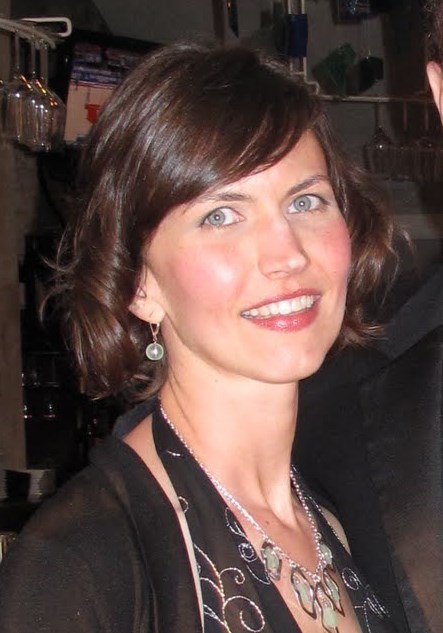
“The fact that the people of Japan are wonderful has only been confirmed with every return visit and every new friend I meet. This is the power of grass roots internationalization and this is the power of the JET Program.”
As the daughter of parents in the State Department, Jessyca (Wilcox) Livingston (Hokkaido, 2003-06) spent her early childhood years immersed in Japan and most of the rest of her youth abroad. After graduating from Rutgers University she worked as a Park Ranger/Ecologist with the National Park Service. Her affinity for Japan led her to return as a JET Program participant. Jessyca spent three years as an ALT in Urahoro-cho, an experience which deepened her love for Japan and its people. Upon returning the USA, she quickly got involved in her local JETAA chapter in the Rocky Mountain region and secured a job at the Consulate General of Japan in Denver as the JET Program Coordinator. Jessyca served as treasurer of RMJETAA from 2008-10, then served two terms as a JETAA USA Country Representative from 2010-2012. She has participated in several conferences ranging from regional to international during her service with JETAA. Jessyca currently serves on the JETAA USA Advisory Board to help to guide and ensure the success of JETAA USA at the national level.
Once a JET, Always a JET
My love affair with Japan started at age one when my family moved to the coastal town of Hayama in Kanagawa Prefecture. My father worked on the nearby navy base and my mother settled into domestic life in Japan while I ran around with the neighborhood kids. I learned Japanese, they learned that there were more than just one kind of people in the world and we all learned that having fun together didn’t depend on what you looked like or what language you spoke. Friendship transcended all of that. That was my first experience with grass-roots internationalization. It was years before the JET Program would be established.
My family moved on to live in other countries, but I was able to return to Japan on several happy occasions. My Japanese language abilities fluctuated, but my Japanese friends remained steadfast. I experienced both the rewards of articulating myself well and the embarrassment of stumbling through sentences and making ungraceful mistakes. Through it all, Japan remained a common thread in my studies and personal life. I studied Japanese in school because I understood it was a vehicle to stay connected to the people and place I loved.
I found the JET Program in a school hallway in the form of a poster. I wrote down the information and filed it away for my future. I knew it had a place in my life. When the time was right, I submitted my application, and waited. Read More
Justin’s Japan: Nippon in New York – From ‘Edo Pop’ to ‘Poppy Hill’
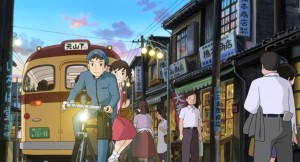
“From Up on Poppy Hill,” the latest film from Studio Ghibli, premieres in New York March 16. (©2011 Chizuru Takahashi/Tetsuro Sayama/GNDHDDT)
By JQ magazine editor Justin Tedaldi (CIR Kobe-shi, 2001-02) for Examiner.com. Visit his Japanese culture page here for related stories.
Tucked between Oscar and cherry blossom season, March offers an unmissable array of concerts, performances and film premieres, along with a special gathering to mark the two-year anniversary of the Tohoku earthquake and tsunami.
This month’s highlights include:
Sunday, March 3, 6:45 p.m.
Exploring the Road of Shamisen – Koto Workshop and Concert
Still Mind Zendo, 37 West 17th Street
$15 advance, $18 at the door
For reservations, email contact[at]marcreation.com or call 917-400-9362
In the latest workshop of the Spring Traditional Japanese Musical Instrument Series, shamisen specialist Yoko Reikano Kimura will demonstrate the vast 400 years of shamisen repertoire and explore the infinite possibilities of the instrument. Shamisen was brought to Japan through the Silk Road and since then it was popularized among samurai to ordinary citizens. But in today’s cosmopolitan age, new shamisen music continues to thrive.
March 6-9
The Bach Variations: Bach and Mendelssohn
Avery Fisher Hall, 10 Lincoln Center Plaza
$41-$123
In its first-ever Bach Festival, a kaleidoscopic three-week celebration of the depth and breadth the man the New York Times named the greatest composer of all time, Kobe-born conductor and harpsichordist Masaaki Suzuki leads five vocalists along with his own Bach Colleguim Japan and Yale Schola Cantorum with his own unique approach, combining his perspective with the virtuosity of the New York Philharmonic. On the program are Bach’s “Motet No. 1: Singet dem Herrn” and “Magnificat,” along with Mendelssohn’s :Magnificat in D Major” and “Christus.”
March 9-June 9
Edo Pop: The Graphic Impact of Japanese Prints
Japan Society, 333 East 47th Street
$12 general admission, $10 students and seniors, Japan Society members and children under 16 free
Edo Pop playfully juxtaposes classic ukiyo-e prints from such masters as Katsushika Hokusai and Utagawa Hiroshige with contemporary works inspired by these artists and their works. Delve into alluring worlds created by the power of Edo period and contemporary popular culture in which change is the only constant. Organized by the Minneapolis Institute of Arts, with the contemporary art selections curated for the New York presentation by Miwako Tezuka, Ph.D., Director, Japan Society Gallery.
For the complete story, click here.
JQ Magazine: JQ&A with JUSTE Program Participant Saiko Goto
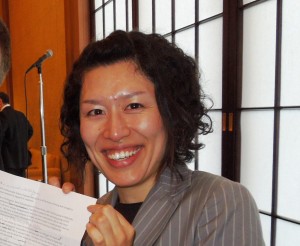
“In Minamisanriku, the local government wanted to keep the shiyakusho (city hall) as a memorial for the tsunami, but people who lost family there disagreed. Finally, the building was demolished recently. It reminded us of sad stories and memories of people who escaped to city hall during the tsunami.” (Courtesy of Saiko Goto)
By Fernando Rojas (Fukui-ken, 2008-10) for JQ magazine. A resident of Teaneck, New Jersey, Fernando was JHS ALT in Fukui prefecture, home of the echizen-gani, a city named Obama, the Fukuisaurus, and nuclear power plants. While in Japan, he picked up shuji (Japanese calligraphy) as his hobby and continues to practice today. He is currently a fellowships associate for the Social Science Research Council’s Abe Fellowship Program in Brooklyn and co-representative for the JETAA New Jersey subchapter.
Hailing from Tome City in Miyagi Prefecture, Saiko Goto was a recent JUSTE Program participant at Rutgers University in New Jersey. Informally called the “Reverse JET Program,” the Japan–U.S. Training and Exchange Program for Language Teachers allows Japanese Teachers of English (JTEs) from all over Japan to take courses in ESL teaching at U.S. universities.
Goto received her teaching license from Gunma Prefecture Women’s University, where she majored in English. She currently teaches at Sakuma Junior High School and has taught English for eight years. Before returning to Japan in January, Goto spoke with JQ about JUSTE and the ongoing impact of the March 11 earthquake and tsunami on her school.
How are teachers selected to participate in the JUSTE program?
Teachers are selected according to their prefectures. In some prefectures, teachers have to apply for the program. In other prefectures, teachers are picked by the board of education. In my case, I was recommended by my principal to the Tome City Board of Education and selected by the Miyagi Prefecture Board of Education.
Have you found the JUSTE program beneficial? In what ways has the program helped you?
Being on JUSTE has been very beneficial. I have met and talked with many people from different countries, as well as learned a lot from them through English. I have also thought more about my teaching and the importance of learning English. The program has also helped me to create more effective activities. I made many activities with other JUSTE members and we will use them in my classes.
Would you recommend the program to other JTEs in Japan?
Definitely. By participating in the program, you can have many chances for meeting people and learn a lot. I visited a former ALT during the winter vacation and experienced life in Arkansas with her and her family. I also became friends with other JUSTE participants. We will share our list of activities with each other online and keep in touch.
Check out the JETAA Ottawa Newsletter
Posted by Gemma Villanueva (Fukushima-ken, 2008-11), editor for the JETAA Ottawa Newsletter. Written and photo submissions are always welcome. Please contact us at newsletter[at]jetaaottawa[dot]ca.
Hello, readers!
JETAA Ottawa is pleased to release the latest newsletter!
Please download here (16 pages – Acrobat Adobe PDF, 808kB).
Adobe Acrobat Reader: Go the “View” menu at the top; then, click “Page Display –> Two-Up Continuous” for optimal viewing.
Happy reading!
In this issue:
1. An exclusive message from His Excellency Kaoru Ishikawa, Ambassador of Japan to Canada.
2. Remembering Tohoku: As the two-year anniversary of the March 11 disaster approaches, current and former Tohoku JETs reflect upon their experiences.
– Catherine Lefrancois profiles “Eyes 4 Fukushima,” a non-profit organization spearheaded by her peers.
– Estelle Hebert helped launch “Brighter Than Tomorrow,” a fundraising campaign supporting a small fishing village in Miyagi which had been affected by the tsunami.
– Gemma Villanueva, a Fukushima JET alumna and the current JETAA Ottawa Newsletter Editor, shares how the quake changed her school.
3. Where Are They Now?: JETAA Ottawa catches up with Rigor Maglaya, who puts his own spin on the JET phrase: “ESID. Every situation is different.”
4. Getting to know the 2013-14 JETAA Ottawa Board of Directors. (Contact list available – PDF, 84KB).
… And much more!
JQ Magazine: Life After JET on YouTube
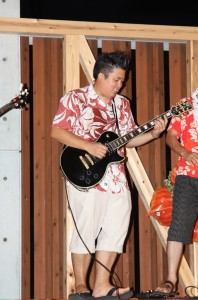
JET alum Eliot Honda: “With my year coming to a close, I wanted to create a set of videos that would not only explain what to expect as an ALT, but also what to expect as an Uwajima ALT. I had truly come to love this city, and I wanted to show off some of its beauty and history.”
By Eliot Honda (Ehime-ken, 2009-2012) for JQ magazine. Born and raised in Honolulu, Eliot was an ALT placed in Uwajima City of Ehime Prefecture. Prior to JET, Eliot worked as a freelance video editor mainly in the commercial and corporate world in San Francisco. Following JET, he returned to Honolulu and joined his mother in real estate. He currently has made a JET Introduction video, and has a YouTube series in the works called Sister City Ties, showing the beauty of the friendship between Honolulu and Uwajima.
My father always preached that “everything happens for a reason.” My being placed in Uwajima was no exception. Uwajima, as I would come to find out, had strong ties to my home of Hawaii. King Kalakaua of Hawaii and Date Munenari of Uwajima had met in 1881, becoming Japan’s first contact with a head of state. Uwajima and Hawaii would meet again in 2001 when the Ehime Maru, a high school fishing vessel, would be struck by a U.S. submarine. Nine lives would be tragically lost, including four high school students.
News of the tragedy spread quickly through Hawaii, causing the people to do everything they could to help the Uwajima families. Whole those families could have shown hate and anger toward the people of Hawaii, they instead embraced the people of the Aloha State with open arms. Through this tragedy, a friendship between Honolulu and Uwajima was born, giving way to the creation of a sister city relationship. To help strengthen the ties between the two cities, the mayor of Uwajima requested ALTs who were born in Hawaii. I found myself to be one of the lucky few chosen to represent Hawaii there as my time on the JET Program began.
I came to Uwajima with all these grand ideas of using video in my lessons. A month into my first year as an Uwajima ALT, I came to the realization that utilizing video in the classroom or in school for that matter would be an impossible task. If finding students willing to speak English in front of the class was difficult, finding students to speak English in front of a camera would be like moving the Hawaiian Islands with a fish hook. (I think only Hawaii people will get that reference.)
Feeling a bit defeated, I sat in my apartment and contemplated how I could put everything I’d learned in the multimedia world to good use. As fate would have, it I was asked by one of the Ehime Maru family members to join the Ehime Maru memorial service, and create a documentary not about the tragedy, but about the friendship between Honolulu and Uwajima. The documentary was for the schools in Ehime, and upon completion, DVDs were given to a large number of schools. This single video became the start of several videos for both the sister city exchange and the promotion of Uwajima.


